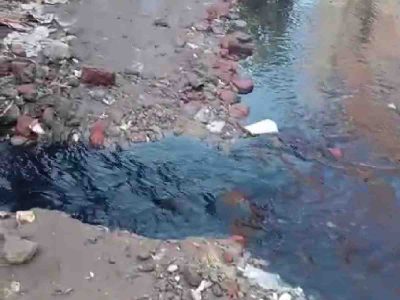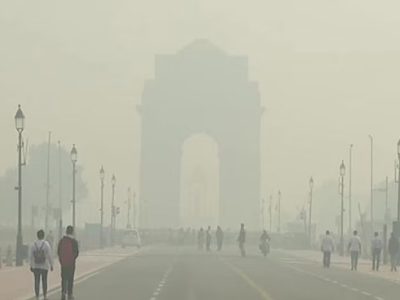Delhi: An estimated 500 or more ‘illegal’ dyeing units are operating across the national capital, consuming around 100 million litres per day (MLD) of water and discharging untreated wastewater directly into Delhi’s drains, Patriot has learnt. Environmentalists claim these illegal operations are a major factor in the alarming depletion of the city’s groundwater.
This massive water wastage occurs in a city where, every summer, residents queue for hours in the sweltering heat, waiting for water tankers to meet their basic needs.
The yarn and textile processing industry—including bleaching, dyeing, printing, and colouring—is classified as a red-category industry, indicating the highest level of pollution. Legally, such industries require valid approvals under the Water Act (1974), the Air Act (1981), and the Hazardous & Other Wastes (Management & Transboundary Movement) Rules.
However, this comes at a time when the newly elected BJP-led Delhi government has been emphasising its commitment to cleaning the Yamuna River.
A ground report on illegal dyeing units
Patriot visited some areas in Delhi where these alleged ‘illegal’ dyeing units operate. The investigation revealed that scores of these units continue to function openly, flouting all environmental norms.
In Sonia Vihar Pushta-1, for instance, drains were overflowing with blue-tinted wastewater from denim dyeing units. The polluted water had spilled onto the streets, creating an unbearable stench and making daily life difficult for residents. Locals expressed frustration, alleging that authorities were complicit in allowing these units to function.
Ashok Kumar, a resident of Sonia Vihar, said, “Scores of dyeing units operate in the locality with the blessing of the authorities because everyone is corrupt. Officials take bribes every month to let these factories continue. These operations have been running for the past two decades.”
“When we tried to raise our voices to shut these dyeing units, we started receiving threats from factory owners. The police also refused to help us,” Kumar added.
Experts estimate that more than 15 such units are operating in Sonia Vihar alone.
The problem extends beyond this area. In Seelampur, drone surveillance by an environmentalist identified approximately 58 illegal dyeing units, many of which use rooftops to dry dyed fabrics. These units are visible from the metro passing over the region.
Residents voiced their concerns, blaming these factories for contaminating drains and roads with chemical-laden wastewater that ultimately flows into the Yamuna.
Meena Kumari, a resident of Seelampur, expressed her frustration, stating, “These factories have been polluting our neighbourhood for years, and no authority has taken strict action. The chemical waste they release contaminates our water supply. Many of us have developed health issues, yet officials continue to turn a blind eye.”
She added, “We feel helpless—whenever we raise our voices, we are either ignored or threatened. How long will we have to suffer before someone takes responsibility?”
A citywide crisis
According to environmentalist Varun Gulati, these illegal dyeing units are not limited to Seelampur and Sonia Vihar. Several other areas in Delhi are also affected, including Bindapur (8 units), Matiala (8), Khyala (35), Meethapur (70), Mukundpur/Narela/Kanjhawla (30), Kirar (5), Bawana (20), Badli (15), Mayapuri (15), Sarita Vihar (20), Ghazipur (30), and Aali Vihar (20).
He argued that the Yamuna River cannot be cleaned unless authorities take decisive action against these illegal units. These operations, he explained, extract vast amounts of groundwater without approval, with dyeing units requiring between two lakh and five lakh litres per day.
“If they apply for legal approval, their activities will be exposed, and they will be denied a water connection. As a result, they illegally tap into groundwater for their operations,” he said.
These units, he further noted, operate in residential areas and discharge untreated industrial effluents into stormwater drains and sewers. The wastewater, he warned, contains highly toxic heavy metals such as lead, cadmium, zinc, and arsenic. Each illegal dyeing unit, he estimated, consumes approximately 200 kilolitres per day (KLD) of groundwater, amounting to a staggering 100 MLD—sufficient to meet the daily water needs of thousands of Delhi residents.
Moreover, this wastewater is not treated in sewage treatment plants (STPs), which are designed only for domestic sewage. If chemically contaminated water enters these plants, they will fail to meet regulatory standards.
Authorities’ response
A senior Delhi Pollution Control Committee (DPCC) official, speaking on condition of anonymity, said, “After receiving a complaint from activist Varun Gulati, we forwarded the matter to the Municipal Corporation of Delhi (MCD) for appropriate action.”
DPCC officials also confirmed that they are preparing a report on the illegal dyeing units to submit to the National Green Tribunal (NGT).
NGT orders DPCC to take stern action
On February 24, the National Green Tribunal (NGT) was informed that action had been taken against dyeing units in Delhi’s Khyala and Meethapur villages. However, an environmental activist highlighted that more illegal units were still operating in these areas. In response, the tribunal directed the DPCC to intensify its efforts and submit a status report within four weeks.
Killing Yamuna’s biodiversity
Environmentalists warn that the unchecked dumping of untreated industrial waste into the Yamuna is a primary cause of biodiversity loss in the river.
“The discharge of toxic chemicals from illegal dyeing units is devastating the Yamuna’s aquatic life and ecosystem. Heavy metals, dyes, and other hazardous substances poison fish, deplete oxygen levels, and make the water so toxic that even resilient species struggle to survive,” said environmental activist Pankaj Kumar.
“These pollutants not only kill marine organisms but also destroy the breeding grounds of native fish species, leading to a sharp population decline. The riverbanks, once home to migratory birds and diverse flora, are now barren due to the chemical-laden waters. If immediate action is not taken, the Yamuna may soon become a lifeless waterway,” added Kumar.
Delhi Jal Board’s 100-day Yamuna plan
Over the next three months, the Delhi Jal Board (DJB) plans to curb untreated sewage discharge into the Yamuna while tackling drain overflow issues across the city. Key initiatives include desilting major underground trunk sewer lines, introducing drainage trapping measures, and upgrading four STPs. The newly elected BJP government has prioritised Yamuna cleanup efforts.
Chemical contaminated water flowing in the drains of Sonia Vihar
Last week, DJB officials met Chief Minister Rekha Gupta and presented a 100-day action plan outlining projects that can be completed within this period. “The Chief Minister responded positively and assured that financial issues hindering DJB’s work would be addressed. The primary goal in sewage management is to prevent untreated waste from entering the Yamuna,” a senior DJB official said.
Also Read: Yamuna pollution: Lethal cocktail of toxins and government apathy
DJB currently operates 37 STPs and is working to expand treatment capacity by upgrading several plants in Rithala, Rohini, and Narela.
Experts sceptical of DJB’s plan
However, experts argue that upgrading STPs alone will not help clean the Yamuna—not even in the next 30 years.
“The Yamuna cannot be cleaned unless the issue of illegal chemical discharge from dyeing units is tackled head-on,” said Gulati. These polluting units, he explained, dump untreated wastewater into stormwater drains, which eventually flow into the Yamuna, rendering cleanup efforts ineffective.
The continued operation of these illegal units, he pointed out, defies multiple Supreme Court and NGT orders. Despite clear directives, MCD has failed to take serious action. “Shockingly, instead of shutting down these units, MCD officials allegedly alert them before inspections or raids, allowing them to evade legal action,” he said.

He further stressed that the government must go beyond superficial measures and take strict action against illegal dyeing units. “Without eliminating these toxic polluters, any attempt to clean the Yamuna will remain a distant dream,” he concluded.
When approached for comment, the MCD did not respond.





